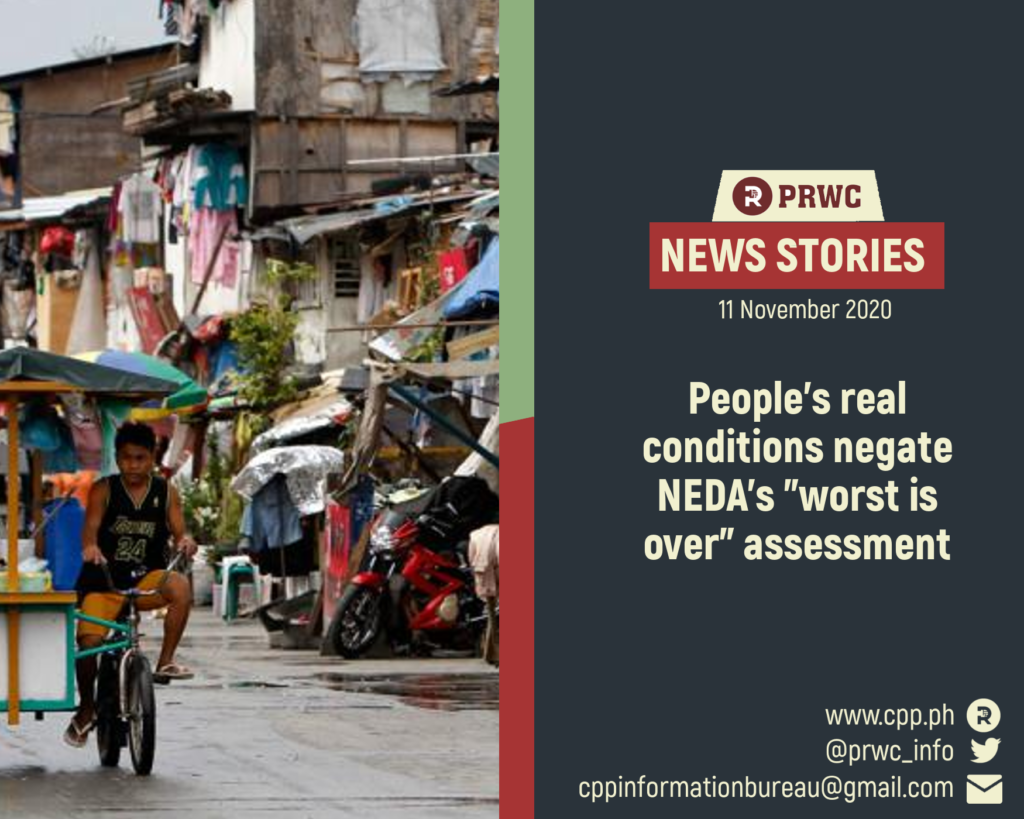People's real conditions negate NEDA's "worst is over" assessment

The Filipino people are not assured by the Duterte regime’s economic managers’ claim that “the worst is over for the country,” as they continue to bear the brunt of the sharp economic crisis caused by the Duterte regime’s failed pandemic response as well as the impact of successive typhoons which slammed the country in recent weeks.
These claims of Socioeconomic Planning Sec. Karl Kendrick Chua made yesterday are completely out of touch with the realities of the broad masses of the people. Millions of Filipinos are reeling from the damages wrought by the typhoons Quinta and Rolly, combined with the worsening inflation, drop in local production and massive unemployment.
More than 140,000 houses were damaged in Calabarzon, Mimaropa, Bicol and the Cordillera Administration Region. Appoximately 26,982 are now homeless after their homes were heavily damaged by typhoons Quinta and Rolly. Electrical lines in across Bicol are yet to be repaired. It is estimated that restoration of electricity in Catanduanes island will take two months.
Farmers suffered big income losses as farmgate prices of agricultural produce dropped while costs of production remain high. On October 28, the Philippine Statistics Authority reported that palay farmgate prices continued to drop for the seventh consecutive weeks. The lowest buying price recorded during the period was P12 per kilo.
Prospects for hog raisers and traders also remain dim as the African Swine Fever continues to spread across the country. Last quarter, hog production slid by 7.7%. Livestock and cattle production also dropped by 7.6% and 10.7%, respectively.
Already hard-up families, especially those affected by the aforementioned calamities and the poorest and unemployed, are now required to further tighten their belts in order to survive as the inflation rate further rose to a three-month high of 2.5% (year-on-year) last month. The highest increases are in the prices of basic food commodities such as meat (4.7%) and fish (3.7%). Tricycle, jeepney and bus fares also increased by 45.8%, 6.4% and 4.1%, respectively.
Data released on Sunday by the Department of Agriculture indicates that huge losses are bound to be shouldered by more than 89,259 farmers and fishermen across Luzon. It reported that the combined damaged wrought by Typhoons Quinta and Rolly has already reached P7.66 billion, with 162,693 hectares of farmlands and 279,071 metric tons of agricultural produce damaged. Reports estimate that back-to-back typhoons resulted in total P17.8 billion in damages in infrastructure (P12.8 billion) and agriculture (P5 billion).
Commodities damaged include rice, corn and vegetables, as well as fishing grounds, livestock, irrigation, and farm equipment. Farmers and households affected by the typhoon are yet to receive any aid or compensation from the reactionary government to recover from their losses and rebuild their livelihood.
Overall, the Philippine economy continue to decline reporting an 11.5% contraction in the gross domestic product (GDP) for the third quarter of 2020. The country is deep in debt and is being bled dry by rising costs of payments.
